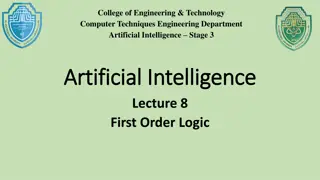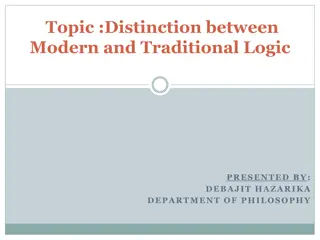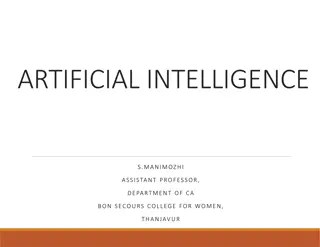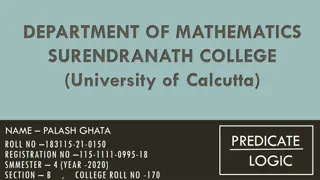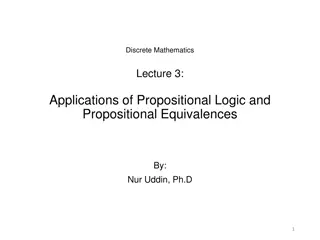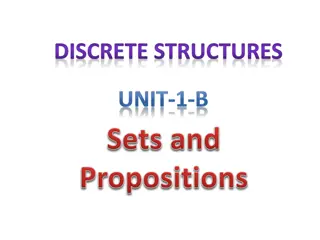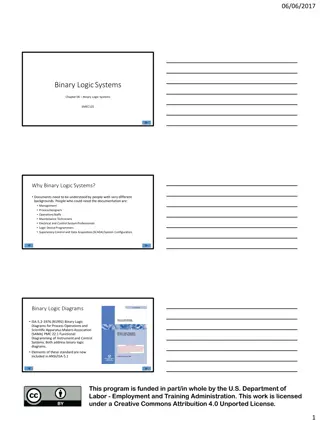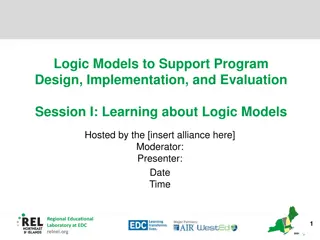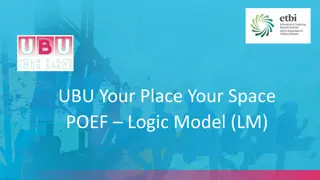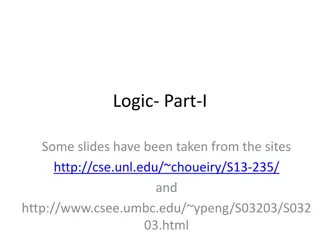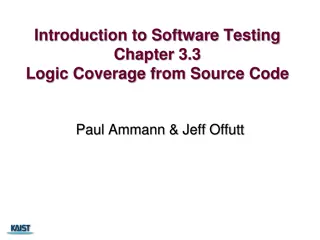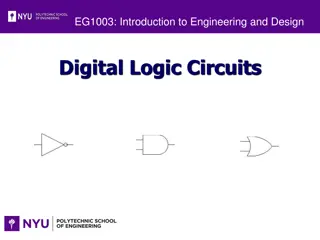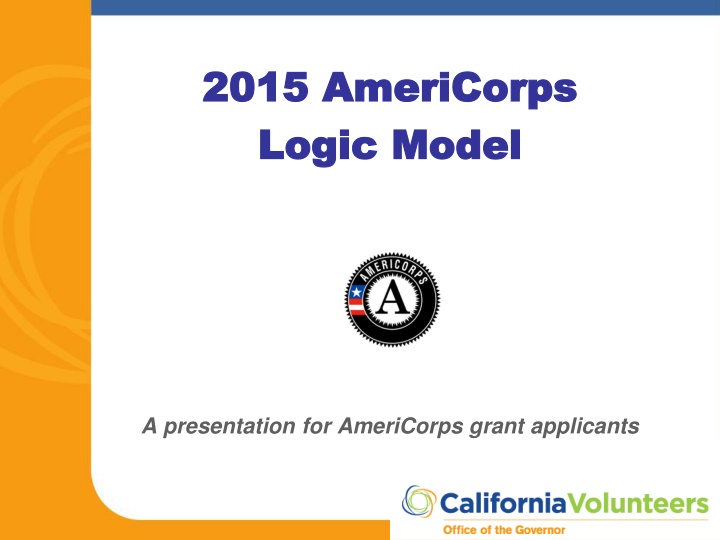
Theory of Change and Logic Models for Effective Program Planning
Explore the key components of theory of change and logic models in program development to address community needs effectively. Learn about community problems, interventions, intended outcomes, and more for successful program implementation.
Download Presentation

Please find below an Image/Link to download the presentation.
The content on the website is provided AS IS for your information and personal use only. It may not be sold, licensed, or shared on other websites without obtaining consent from the author. If you encounter any issues during the download, it is possible that the publisher has removed the file from their server.
You are allowed to download the files provided on this website for personal or commercial use, subject to the condition that they are used lawfully. All files are the property of their respective owners.
The content on the website is provided AS IS for your information and personal use only. It may not be sold, licensed, or shared on other websites without obtaining consent from the author.
E N D
Presentation Transcript
2015 AmeriCorps 2015 AmeriCorps Logic Model Logic Model A presentation for AmeriCorps grant applicants
Important Dates Important Dates November 3, 2014 Notice of Intent to Apply Due by 4:00pm November 24, 2014 Applications Due by 5:00pm Week of December 22, 2014 Clarification Requests for Competitive Dec. 29, 2014 Jan. 2, 2015 In-person Clarification Interview January 5, 2015 Clarification Response/Competitive Rewrite Due to CV Competitive Applications due in eGrants January 16, 2015 January 17-21, 2015 eGrants Application Review/Final Edits April 2015 CV Issues Clarification Request for Formula Waitlist Funding Results Announced June 2015 July October 2015 Contracting Process and Program Launch
Purpose of this Webinar Purpose of this Webinar Describe and understand the components of a theory of change Describe and understand the components of a logic model Answer any questions about theories of change and logic models
Theory of Change Theory of Change Organizing principle of a program The theory that the program s specific intervention to address a community need will provide the intended outcomes Community Problem/Need Specific Intervention Intended Outcome
Community Community Problem/Need Problem/Need Community Problem/Need is the specific issue your program, with its specific intervention, is designed to address Data documenting the problem/need should answer the following questions: SCOPE: Who and how many are directly affected? How severe is this? SIGNIFICANCE: What makes this a compelling need? Is it likely to become worse? What will happen if we do nothing? CAUSE(S): Why does the need exist? How is it perpetuated?
Intended Outcome Intended Outcome Consider first what change you want your program to make Once you know where you want to go, you can determine how to get there
Intervention Intervention The intervention is the specific set of activities in which your program s participants and volunteers will be engaged. Describe the design and dosage of your intervention: DESIGN: Who does what with whom? DOSAGE Frequency: How many sessions a week? Intensity: Length of each session? Duration: How many total weeks of sessions?
Evidence Base Evidence Base Your theory of change must be based in evidence You will need evidence that the community need is present at the scope and scale you describe, and that your proposed intervention will likely lead to the intended outcomes
Example Example Community Problem/Need Specific Intervention Intended Outcome Individualized tutoring 3 times/week for 20 minutes on five building block literacy skills through reading, writing, and verbal communication activities Children reading below grade level in 3rd grade Statistics on the number of students at below grade level in program s service area; Research on why reading proficiency by 3rd grade is important Students are able to read at 3rd grade level (as measured by 3rd grade reading exam) Evidence: Research on building block skills leading to reading proficiency. Research on design and dosage of tutoring sessions.
Theory of Theory of Change in the Application in the Application Change The theory of change is presented in the Program Narrative. Problem/Need Theory of Change and Logic Model Evidence Base
Logic Model Logic Model A detailed visual representation of a program and its theory of change Communicates how a program works by depicting the intended relationships among program components: Inputs or resources Activities Outputs Outcomes Outcomes Inputs Activities Outputs Short Medium Long
Logic Logic Model Components: Model Components: Inputs Inputs Outcomes Inputs Activities Outputs Short Medium Long Inputs or resources include the human, financial, organizational, and community resources available for carrying out a program s activities.
Logic Logic Model Components: Model Components: Activities Activities Outcomes Inputs Activities Outputs Short Medium Long Activities are the processes, tools, events, and actions that are used to bring about a program s intended changes or results.
Logic Logic Model Components: Model Components: Outputs Outputs Outcomes Inputs Activities Outputs Short Medium Long Outputs are the direct products of a program s activities and may include types, levels and targets of services to be delivered by the program.
Logic Logic Model Components: Model Components: Outcomes Outcomes Outcomes Inputs Activities Outputs Short Medium Long Outcomes are the expected changes in the population served that result from a program s activities and fall along a continuum, ranging from short to long term results: Short-term: changes in knowledge, skills, and/or attitudes Medium-term: changes in behavior or action Long-term: changes in condition or status in life
Outputs and Outcomes Outputs and Outcomes Outcomes Changes resulting from a program s activities/services Outputs Direct products of a program s activities/services Quantify changes in knowledge, attitude, behavior, or condition Often expressed numerically or quantified in some way
Logic Model Logic Model in the Application in the Application Be consistent with the theory of change Identify how outputs will be measured Identify the performance measures that will be used as outcome indicators Should be able to track and report on short- and medium-term outcomes. We do not expect you to report on longer-term outcomes annually. We do expect to see reports on the longer-term outcomes in a recompeting applications.
Technical Assistance Technical Assistance Webinars Webinars RFA Guidance and Application Instructions Overview Tuesday, October 28, 10:00 11:30 am PDT Tuesday, October 28, 2:00 3:30 pm PDT AmeriCorps Program Logic Model Wednesday, October 29, 2:00 3:30 pm PDT California Performance Measurement Worksheets (PMWs) Thursday, October 30, 2:00 3:30 pm PDT AmeriCorps Application Components Q & A Friday, October 31, 10:00 11:00 am PDT
Questions? Questions? Email any questions to Funding@CaliforniaVolunteers.ca.gov FAQs will be posted weekly on Thursday mornings on CV s website: www.californiavolunteers.org/ index.php/Grants/americorps/
Thanks! Thanks! Notice of Intent due Monday, November 3, 2014 Final Application due Monday, November 24, 2014

